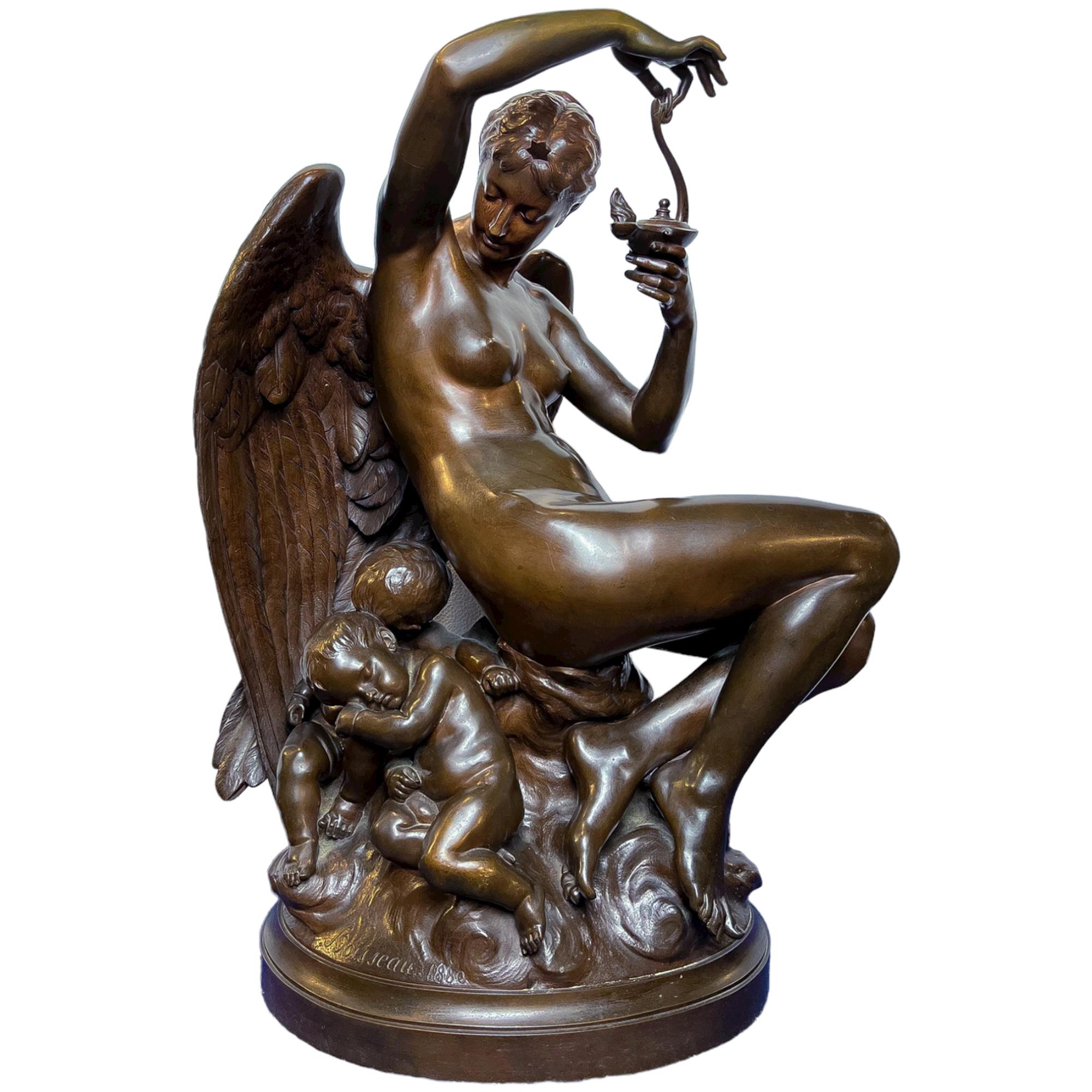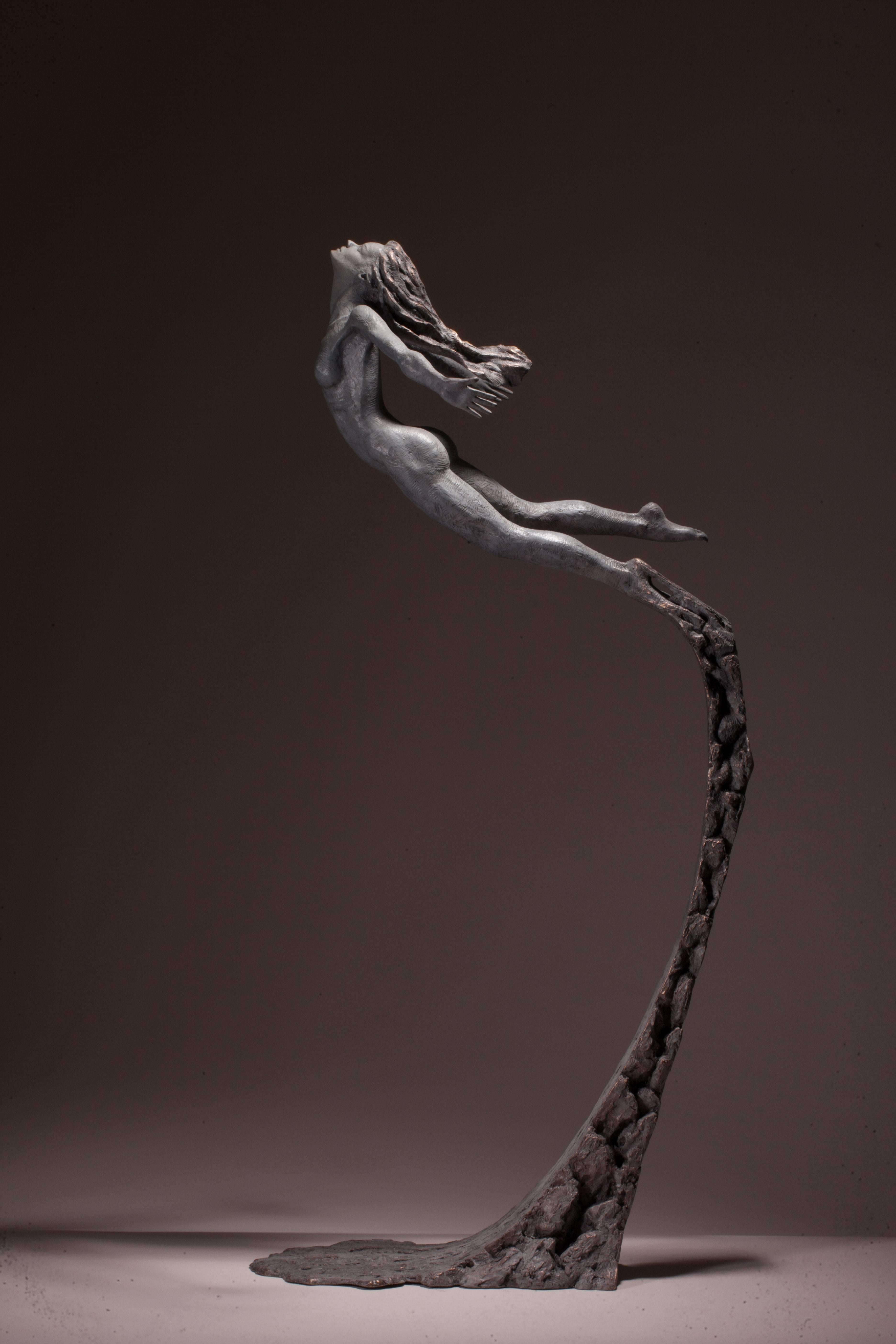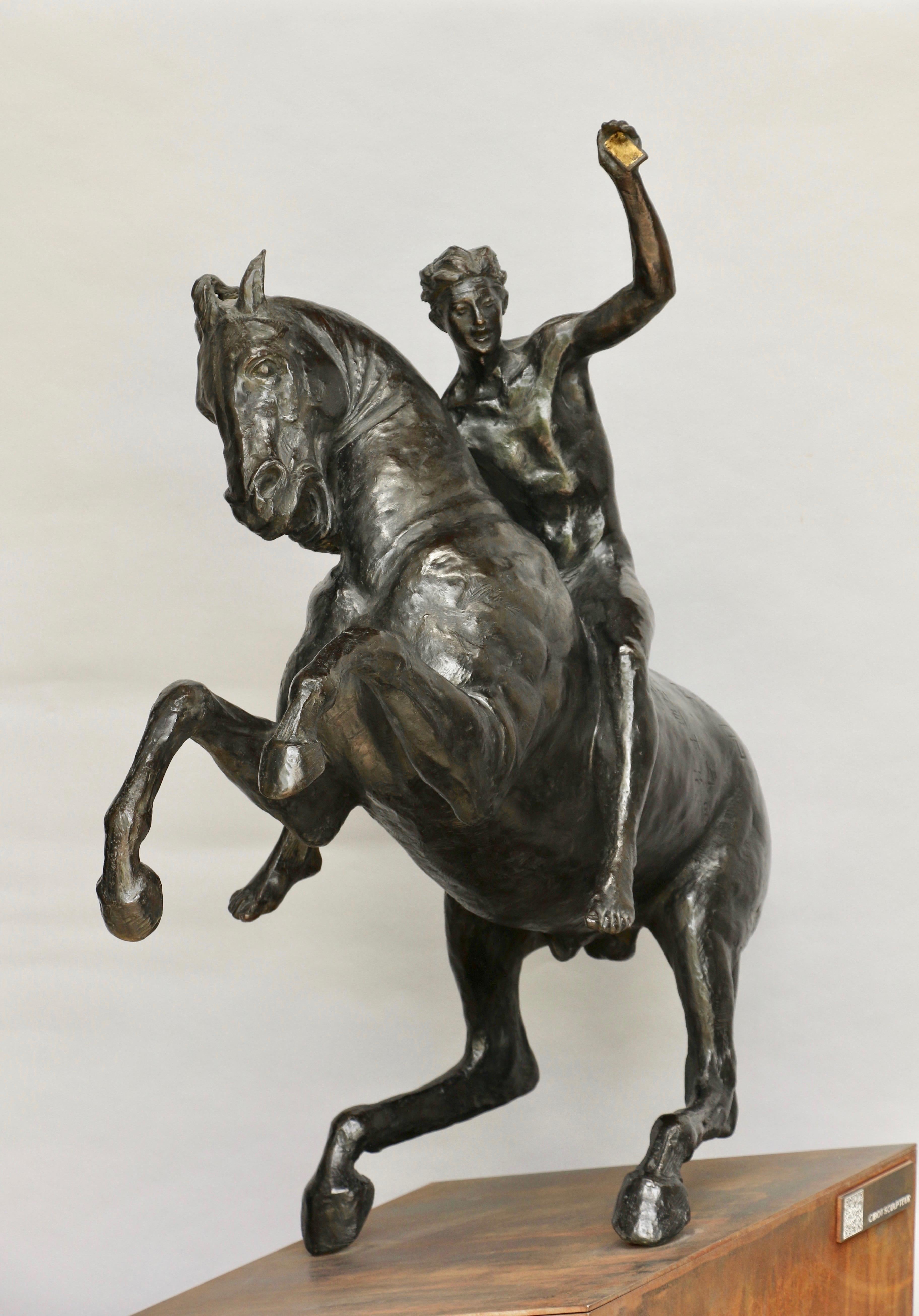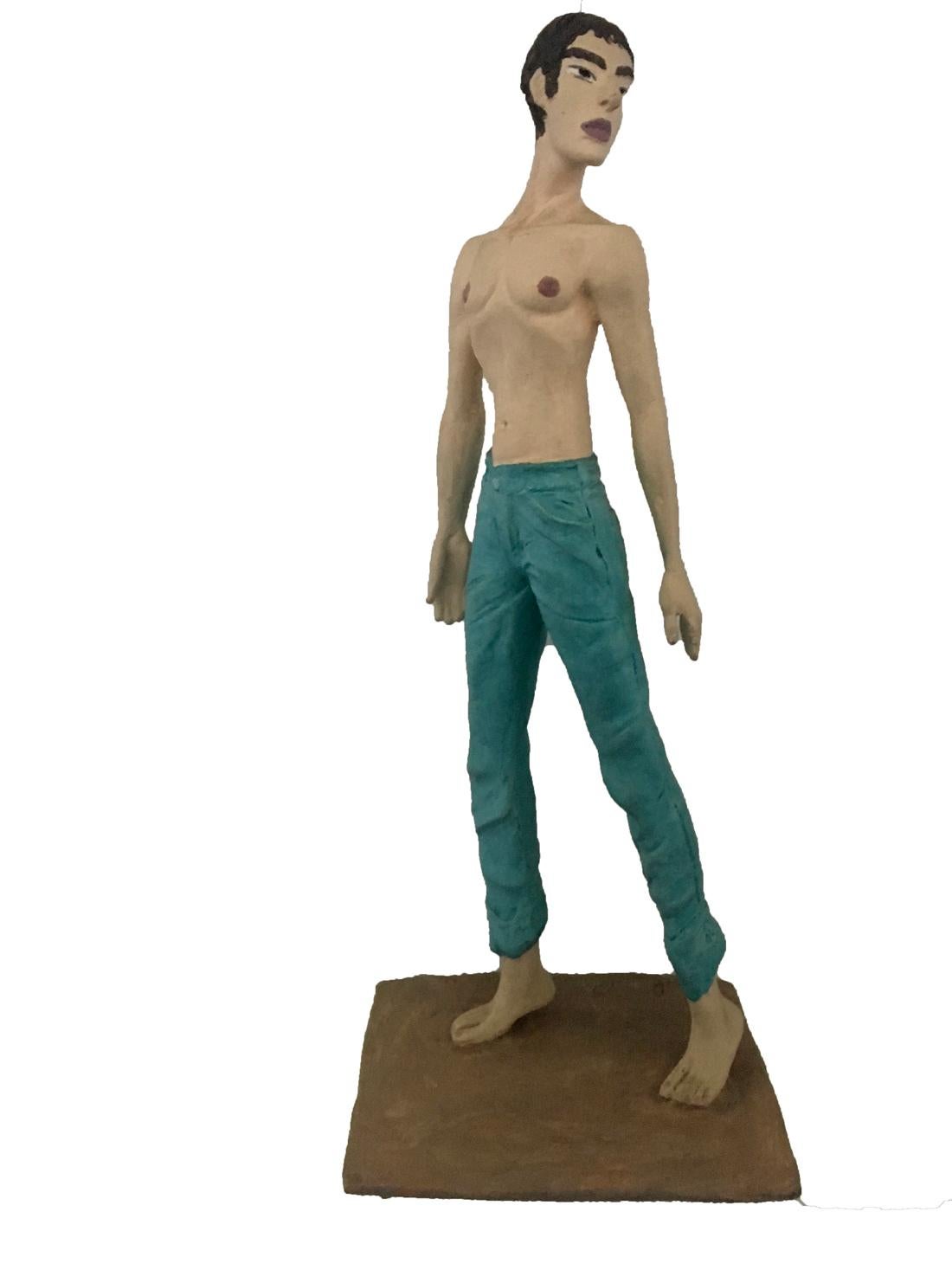Items Similar to Music Making Dancing Putti – 19thC France - High Relief Bronze Plaque
Want more images or videos?
Request additional images or videos from the seller
1 of 12
Music Making Dancing Putti – 19thC France - High Relief Bronze Plaquec. 1880
c. 1880
About the Item
Putti Making Music
(French)
• Bronze Plaque, ca. 25 x 28 cm
• Weight ca. 2480 gramms
Worldwide shipping for this object is complimentary - There are no additional charges for handling & delivery.
A substantial relief, depicting a well shaped group of three putti, draped in swirling ribbons and veils, dancing and making music. This animated plaque, in cast in the manner of Claude Michel (20 December 1738 – 29 March 1814), known as Clodion, who was a French sculptor in the Roccoco, especially noted for his works in marble, bronze, & terracotta.
Cast bronze plaques are notoriously difficult to date, as it common to take molds of earlier existing examples in sand and recast the object. Of course detail and shaping is lost with every generation. Also, later casts seem to be lighter and thinish.
I have see no reason, to not date this heavy plaque to 19th century France.
The figures details are well defined and the patina is pleasing. The back looks good, with usual wear and some old sand in the depressions. There are no dammages, except a tiny, unnoticable cavity/casting bubble in the chest of the putti on the right, the relief is in delightfull condition. Perfectly ready to display.
Worldwide shipping is complimentary - There are no additional charges for handling & delivery.
I am Adrian Stuart Grond trading as ASGrond - Art & Antiques. Passionate collector, purveyor and artist. Here on 1stdibs I am offering Fine Art that I have collected over the last thirty years.
Phantoms of Time - Things of the past - for you to add to your future and so enriching your life’s tapestry. I often choose to leave objects in the state I acquired them, chiefly to retain as much of their originality as possible, but also to leave open all options regarding the object’s future treatment and appearance. Examine the provided photographs and ask questions. I am here to assist you to my best of knowledge. Although I do of course accept returns, costs are incurred on both sides – so be sure you are confident regarding condition before purchase of any item. With some of the larger and or more valuable objects, I prefer to let 1stDibs handle delivery. However, most of my stock I deliver worldwide for free– so no extra costs on top of the sale price for those items. I do decline to accept responsibility for any declaration made to the customs authority concerning import and export. These include age, value and provenience and so on as well as the taxes concerning these. Meaning, you the buyer cover all incurring import costs, duties and taxes on your end. I pack the goods myself and very carefully. Where it makes sense, for environmental reasons I will use recycled packing materials. I ship using the Swiss Postal Priority Service and all shipments are fully insured.
Thank you for your interest and please note, that I offer free worldwide shipping on most items.
- Creation Year:c. 1880
- Dimensions:Height: 9.85 in (25 cm)Width: 11.03 in (28 cm)Depth: 1.97 in (5 cm)
- Medium:
- Movement & Style:
- Circle Of:Claude Michel Clodion
- Period:
- Condition:
- Gallery Location:Meinisberg, CH
- Reference Number:
About the Seller
5.0
Vetted Seller
These experienced sellers undergo a comprehensive evaluation by our team of in-house experts.
Established in 2013
1stDibs seller since 2021
35 sales on 1stDibs
- ShippingRetrieving quote...Ships From: Meinisberg, Switzerland
- Return PolicyA return for this item may be initiated within 3 days of delivery.
More From This SellerView All
- Symbolist Wrought Iron Sculpture 1890 / 1920 of a Serpent coiled in the TreeLocated in Meinisberg, CHSymbolist Wrought Iron Sculpture of a Snake coiled around a Tree • Height, ca. 13 cm • Width, ca. 15.5 cm (measured at the base) • Depth, ca. 11 cm (Measured at the base) • Weight, ...Category
Late 19th Century Naturalistic Figurative Sculptures
MaterialsIron
- Meteorite Twannberg 128 gramms Swiss Hexahedrite Iron Shaped by Nature TW 1253Located in Meinisberg, CHA Natural Iron Sculpture Shaped by Nature The sculptured Meteorite is presented on a polished, black and white flamed marble block and held in place by a strong magnet. The specimen can be removed or positioned according to the liking of the owner. Worldwide shipping for this object is complimentary - There are no additional charges for handling & delivery. DETAILS: • Weight: 128 grams • Dimensions: Ca. 70 x 55 x 25 mm • Find Date: 27th of December 2018 • Find spot: 47° 8.193’ N / 7°8.320’ E • Treatment: The Specimen’s surface has been desalinated and coated with micro layer of paraffin (reversable) • Official name: TW 1253 About the Swiss Twannberg Meteorite: • Fall occurred about 150'000 years ago or earlIer • To date (end of 2021) 2020 individual fragments have been found • Total weight 150 kilograms • Rare Hexahedrite / Octahedrite IIG iron • Worldwide there are only six meteorites classified as Hexaedrite IIG iron, out of which the Twannberg is the only European fall. • Very low nickel content of 4.5 % • High content of phosphorus within crystalline Schreibersite (Iron phosphide) • The Twannberg meteorite is by far the biggest of the eleven Swiss meteorites known to date • The strewn field is one of the largest in Europe and probably the best documented fall in the world Worldwide shipping is complimentary - There are no additional charges for handling & delivery. I am a member of the Citizen-Science-Project organized by Professor Doctor Beda Hofmann, head of Earth Sciences department, of the Natural History Museum of Berne, Switzerland, researching the strewn field of the Twannberg meteorite on the Plateau de Diesse in Switzerland. Every found meteorite is analyzed for its metallurgical composition, measured and inspected for inclusions in the oxidation crust, flow lines and other surface properties. The meteorite is given its unique number beginning with TW for ‘Twannberg’ and then returned in accordance with the agreement between the Cantone of Berne and the finder – Meaning all finds are shared, depending on weight and rarity. We search in all seasons a large area in the Bernese Jura up to about 1500 meters above sea with sophisticated metal detectors – sometimes in lovely pasture, other times we negotiate very steep, forested slopes taking considerable risks. Unfortunately, we get a huge number of false signals and dig up a considerable number of discarded and lost metal objects, such as horse and cow shoes, nails, bits of fencing, artillery fragments and bullets, rubbish, etc. To find one meteorite a searcher has to dig hundreds of false signals often in arduous conditions. Hence, we have only found 2000 individual specimens since 1984. Many finders hold on to their allocated meteorites, so few of those rare good quality specimens actually reach the open market. I am happy to pass on my larger meteorites, whilst I hold on to the small, gem quality Twannberg meteorites, which I plan to use for my new, upcoming jewelry collection. Not all specimens found are of the same quality. Being iron they are often heavily oxidized, become instable and start to crumble. However, a small percentage of meteorites fell into an area, where the acidic soil layer is very thin and sunk down on the more stable, alkaline lime gravel layer which makes up the Jura hills – virtually a more or less neutral zone. So, I would estimate about 10% of all meteorites are found, still retaining parts of their dark, outer crust after all those years. If it happens, that the spot is located high enough, i.e. out of reach of the glaciers which covered the area at least twice since the fall and mulled everything over in their path, the meteorite would wait unharmed patiently for over 150’000 years for someone to find it. If then, the meteorite is above average weight and it displays an attractive sculptured shape, we are talking about the absolute rarest possible type of Twannberg Meteorite, of which there were only a few hand full found. I am selling here a well sized, superbly sculptured, Twannberg meteorite specimen...Category
15th Century and Earlier Abstract Abstract Sculptures
MaterialsIron
- 17thC Spanish Colonial School Frame with orig. Painting St. Joseph Jesus ChildBy Spanish Colonial (Peruvian)Located in Meinisberg, CH17th Century Spanish Colonial School (Likely to be School of Cuzco in Peru) - St. Joseph with the Christ Child carrying a basket, housed in its original carved, hardwood frame. • Painted in oil on canvas (laid on to fiberboard), ca.58 x 48 cm • Original frame, ca. 64 x 54 cm • Visible image ca. 52.5 x 42.5 cm Centuries ago this religious painting, depicting St. Joseph with his flowering staff and the Christ Child carrying a basket, was originally displayed in a church or chapel in 17th Century colonial...Category
17th Century Old Masters Figurative Paintings
MaterialsGold Leaf
- The Lute Player - A Flemish Interior after David Teniers II - 18thC Oil PaintingBy David Teniers the YoungerLocated in Meinisberg, CHThe Lute Player, the Flute Player and Singers making Music • 18thC Oil on iron sheet, ca. 32 x 26.5 cm • Later Frame, ca. 40 x 34 cm Here we have a...Category
Late 18th Century Naturalistic Figurative Paintings
MaterialsIron
- László Bornemisza (1910-1995) Toscana - Fairy Town in Oil on Gold Leaf PaintingBy László BornemiszaLocated in Meinisberg, CHLászló Bornemisza (Hungarian, 1910-1995) Toscana – A Fairy Landscape • Mixed media: Oils & gold leaf on artist board, ca. 10.7 x 16 cm • Gold leaf ...Category
Mid-20th Century Surrealist Figurative Paintings
MaterialsGold Leaf
- Ernst LINCK (1874 - 1935) Farmhouse with Clothesline School of Berne SwitzerlandLocated in Meinisberg, CHErnst Link (Swiss, ∗ 14th of October, 1874 in Windisch, † 29th of June, 1935 in Bern) Stöckli with Clothesline • Oil painting on canvas approx. 25.5 x 26.5 cm • Pine frame approx. 34.5 x 35.5 cm (obvious signs of age) • Signed lower right Worldwide shipping for this object is complimentary - There are no additional charges for handling & delivery. A most pleasant depiction of a typical ‘Stöckli’ in bright sunshine with the a few shirts on the washing line, somewhere in the Canton of Berne in Switzerland. Such small cottages would sit next to the large farmhouses and upon retirement the old couple would move into it, to make room for the next generation to take up residence in the main building and run the farm. The Painting is in pleasingly good and clean condition, with no damage or restoration Ernst Linck was an important representative of the "Berner Schule" (Bernese school) led by the famous Ferdinand Hodler, which also included Traugott Senn, Emil Cardinaux, Eduard Boss...Category
Early 1900s Post-Impressionist Landscape Paintings
MaterialsCanvas, Oil
You May Also Like
- Bronze Female Statue "Le Crépuscule" by Emile Andre BoisseauLocated in New York, NYEmile-Andre Boisseau (French, 1842-1923) Le Crépuscule signed 'E. Boisseau' (on the base) Bronze height: 29 in. (74 cm.) Emile-André Boisseau was a...Category
19th Century Rococo Figurative Sculptures
MaterialsBronze
- Louvre, Bronze after P. Julien Executed from a Marble Ordered by Marie-AntoinetteLocated in Paris, FRThis splendid sculpture represents Young Girl with a Goat (Amalthea and Jupiter's Goat), after the original by Pierre Julien commissioned by Louis XVI in 1785 and completed in 1787 for the cot of Queen Marie-Antoinette in Rambouillet. The work of the sculptor Pierre Julien decorated the interior of a grotto in a pavilion decorated with bas-reliefs by the same sculptor (acquired by the State by dation in 2003). The work was the main element of a rock basin, which was destroyed during the renovation of the gardens of the small castle. The same sculpture was seized during the Revolution and exhibited in the Louvre from 1829. The terracotta sketch, which belonged to the collector Ernst May, must have adorned his château de la Couharde (Yvelines) before entering the Louvre's collections in 1920. The bronze set with a beautiful gilded patina presented here is a work after the original by Pierre Julien (1731-1804) and dates from the 19th century (around 1850). The superbly preserved sculpture, which has belonged to the same family since its acquisition, is presented on its original base in grey serpentine marble. The quality of this work is doubly certified: - on the one hand it is stamped with a round stamp at the top "A. This stamp is a sign of high quality. Achille Collas (1794 - 1859) was the French engineer, engraver and illustrator, inventor among other things of the patented mathematical reduction process of the 19th century to reproduce sculpted objects in reduction, which was very successful. He was awarded a prize at the 1855 exhibition: his "Procédé mécanique", the name under which he prints all his productions, is easily recognisable by the finesse of its execution and by the famous stamp which appears on the base (terrace) of this sculpture. - On the other hand, an important signature is found on the terrace of the sculpture "F. Barbedienne Fondeur", founder. In 1844, Achille Collas, in order to protect his invention, formed the Société Collas et Barbedienne (Paris) with the art founder Ferdinand Barbedienne (1810-1892), which began to produce and sell famous but smaller sculptures in plaster, wood, bronze or ivory. The first object to be marketed was the Venus de Milo after the original in the Louvre Museum. Other sculptures such as the sculpture of George Washington, of which a bronze bust was made by the Barbedienne & Process Collas foundry, are currently in the Metropolitan Museum of Art. HEIGHT OF THE SCULPTURE without base 69CM + BASE = 84CM WIDTH OF THE SCULPTURE without base 28 CM + BASE = 30,5 CM LENGTH OF THE SCULPTURE without base 46 CM + BASE 51 CM The Collas and Barbedienne company was highlighted at the Great Exhibition in London in 1851, the objects of the Barbedienne foundry received a medal and sales soared. At the 1889 Universal Exhibition in Paris, the Barbedienne company again presented a large number of its compositions, including the large neo-Renaissance clock of 1878. This clock, which was part of the Leblanc-Barbedienne estate, was donated by his heirs to the city of Paris, and is kept in the city hall. Pierre Julien (20 June 1731 - 17 December 1804) was a French neo-classical sculptor who worked in the full range of rococo and neoclassical styles. He had an early apprenticeship in Le Puy-en-Velay, near his native village of Saint-Paulien, and then at the École de Dessin in Lyon, before entering the Paris workshop of Guillaume Coustou le Jeune. In 1765, he won the Prix de Rome for sculpture with a bas-relief panel depicting a subject from Antiquity and entered the Royal School for Protected Pupils, which offered a special curriculum under the direction of the painter Louis-Michel van Loo. He was a boarder at the Académie de France in Rome from 1768 to 1773, where he was influenced by the wave of neoclassicism affecting his fellow students. As boarders were required to do, he sent back to France a slightly reduced marble copy of the so-called Cleopatra, the Sleeping Ariadne from the Vatican, which survives in Versailles. Back in France and with his former master, he worked on the sculpture of the mausoleum of Louis, the Grand Dauphin, in the cathedral of Sens. After a failed attempt in 1776, with his Ganymede, he was accepted by the Royal Academy of Painting and Sculpture in 1778, with a Dying Gladiator. He was appointed one of the first members of the Institut de France in 1795, and knight of the Legion of Honour in 1804. He was commissioned by the Count of Angiviller, director of the King's Buildings, on behalf of Louis XVI, to paint the figures for a series of life-size portraits of the great men of France: he produced a Jean de La Fontaine and a Nicolas Poussin, whom he chose to depict in a nightgown, similar to the draperies of a Roman toga. While fulfilling commissions in Paris, for the church of Sainte-Geneviève (now the Panthéon, Paris), or for the Pavillon de Flore in the Louvre, he sculpted in 1785 a virtuoso marble set representing the nymph Amalthée and Jupiter's nurse goat for the Queen's Dairy at the Château de Rambouillet; for his model, he adapted the pose of the famous Venus of the Capitoline. The bas-reliefs of the Dairy, considered his masterpieces, were sold at auction in 1819, but were recovered by the State in 2005, thanks to a gift from the son of the great dealer-collector Daniel Wildenstein. 19th century French school, after Pierre Julien (1731-1804)Amalthea and Jupiter's Goat Bronze with a light brown patina and gilding, reduction made after the marble by Pierre-Julien 1785 executed for Marie-Antoinette at the Laiterie du parc du château de Rambouillet in the Louvre Museum. Among his major works: - Dying Gladiator, marble, 1779, Musée du Louvre. - Ganymede pouring nectar to Jupiter changed into an eagle, [4] marble group, 1776-1778, Paris, Musée du Louvre. - Jean de La Fontaine, marble, 1783-85. Musée du Louvre - Nicolas Poussin, marble, 1789 - 1804. Musée du Louvre - Sketch of a model in terracotta by Nicolas Poussin, ca. 1787 - 1788. Musée du Louvre - Amalthea and Jupiter's goat, marble group, 1787 for the Rambouillet Dairy. The Queen's Dairy at Rambouillet - The girl with the goat, terracotta statuette, 1786. Louvre Museum - Sainte Geneviève restoring her mother's sight, terracotta bas-relief, 1776. Musée du Louvre The works of the famous sculptor Pierre Julien have been referenced in several books and catalogues, including The exhibition catalogue. Gilles Grandjean and Guilhem Scherf. "Pierre Julien 1731-1804". Le Puy-en-Velay, France: Musée Crozatier, 2004. The Lure of Classical Sculpture 1500-1900 (Yale University Press, 1981), cat. no. 24, pp 184-87). Michael Preston Worley, 2003. Pierre Julien: Sculptor to Queen Marie Antoinette. The first modern monograph. Europe in the age of enlightenment and revolution, a catalogue from the libraries of the Metropolitan Museum of Art (fully available online in PDF format), which contains information on Julien. Excerpts from the Grove Dictionary of Art online Pierre Julien in American Public Collections, on the French Sculpture Census website STATUE BARE (BODY) NANNY GOAT (ANIMAL) AMALTHAEA SITTING WOMAN ABOUT US: AYN GALLERY is located in the heart of old Paris on the Ile Saint-Louis surrounded by the Seine, in the most prestigious district of Paris. Just a few steps away from Notre Dame, like a village, this place preserved from urbanists offers a setting as it existed centuries ago with its numerous private mansions which earned the island the nickname "island of palaces" and its illustrious occupants: Charles Baudelaire, Marie Curie, Georges Pompidou or Camille Claudel Our gallery is located just opposite one of the oldest churches in Paris. As the eponymous name of the place indicates, Yasmine Azzi, the owner and artistic director of the place, has a keen eye. Born from the desire to bring together, in a unique space, vintage pieces of 20th century design, contemporary creations, original works of art and interior design know-how, AYN GALLERY was created in 2017. Our gallery presents an eclectic and daring mix, driven by a total freedom of styles and periods. We offer a collection that combines aesthetics and authenticity, in a word what we like and what our customers like. We offer an inspiring selection of furniture from the last century with rare antiques, but also precious objects and lighting with a special emphasis on vintage Italian...Category
19th Century Rococo Figurative Sculptures
MaterialsMarble, Bronze
- Statue of Athlete: Large Academic Style Bronze Figurative Sculpture of Nude MaleBy Mark BeardLocated in Hudson, NYmodern figurative bronze sculpture of a nude athlete 8.5 feet tall and measures 36 inches at the widest point bottom base measures ...Category
Early 2000s Academic Figurative Sculptures
MaterialsBronze
- Ian Edwards - Leap Within Faith - Original Signed Bronze SculpureBy Ian EdwardsLocated in Collonge Bellerive, Geneve, CHIan Edwards - Leap Within Faith - Original Signed Bronze Sculpure Dimensions: 170 x 55 x 40 cm Edition of 12 Edwards’ practice expresses the power and determination of human endea...Category
2010s Contemporary Nude Sculptures
MaterialsBronze
- 2049 Rider Big Model BronzeBy Elisabeth CibotLocated in Pasadena, CABronze 1/3 black patina or gold leaf Korten steel base leaving sculpture on wheels, water jet engraving QR coded cartridge. Born in 1960 in a family of artists collecting the br...Category
2010s Contemporary Figurative Sculptures
MaterialsBronze
- Gianmario Italy 1987 Polychrome Cast Bronze Proof of AuthorLocated in Brescia, ITPaolo Cassarà, this Italian artist, usually utilized painted terracotta in real human dimensions for his Surrealist artworks. It was exceptional the use...Category
20th Century Surrealist Figurative Sculptures
MaterialsBronze
Recently Viewed
View AllMore Ways To Browse
French Relief
High Relief
French Plaque
Antique French Plaque
Bronze Plaque
Antique Relief Sculpture
French Bronze Relief
French Putti
Bronze Relief Sculpture
Bronze Antique Plaques Bronze Plaques
Antique Bronze Plaque
Antique Bronze Plaques
French Rococo Art
Bronze Putti
High Relief Sculpture
Michel Bronze
Large Antique Relief
Antique Marble Relief





